Greek Art Is Said to Be Humanistic Because It Refers to
In the times of the Aboriginal Egyptian and Mesopotamian, information technology was believed that everything on Earth should exist based around God. Whatsoever you do in life, God should exist your influence from what job you should have to what tree you should plant. As time passed by this ideology was tossed over for the idea of humanism. The idea that the globe revolves around the man. No longer should your doings exist based by gods but you decide what you lot do. This gave homo more than value and more independence from a higher power.
From the perspective of fine art, Mesopotamia'southward homo sculptures usually depicted an ordinary human with a normal physique. But due to the Greeks dearest of sports and athletes all of their human sculptures are men with god-like attributes, a nearly inhuman physique due to their humanism.
The gods of Mesopotamia were deities who were never compared to human and don't live among humans. Every bit well only priests were allowed to serve them directly and others would accept to come to a place of gathering to enquire things from them. Unlike the Mesopotamian, the Greeks saw gods as human-like featured creatures with extraordinary abilities. There are stories that these gods would assimilate with the humans even become animals, as well they take man emotions and desires like every other man. Any Greek could pray to the gods from any identify. Through the Greek'south adaption of humanism, they were able to focus on the world versus the deities they worshiped.
Humanism in art is all about having the human being body as the cardinal focus. Humanism can be represented in whatever painting, sculpture, orpiece of work of literature. This concept focuses more on realistic artwork rather than focusing on the opposite. During ancient Mesopotamia and ancient Egypt, the art was filled with gods and supernatural creatures and it represented a lot of what the people at that time were focused on.  We can always refer to the Lammasu that came from aboriginal Sumeria. The Lammasu was known as a protective deity, and it consisted of a combination between a human and fauna. This deity had a man head with a panthera leo body and the wings of a bird. People would put this symbol of protection exterior their homes.
We can always refer to the Lammasu that came from aboriginal Sumeria. The Lammasu was known as a protective deity, and it consisted of a combination between a human and fauna. This deity had a man head with a panthera leo body and the wings of a bird. People would put this symbol of protection exterior their homes.
Hunefer "Book of the Expressionless" papyrus coil can all be looked at to bear witness how supernatural was heavily shown in ancient Egyptian. This curlicue depicts Hunefer, who was a royal scribe, in the afterlife going through a procedure to run into if he is fit to live in the underworld. We start see him in front of these deities with some type of ritual words or prayers underneath, as if he needed to perform these to them to pass. Afterward on, we meet him with Anubis, God of the underworld, who is looking at these scales that determine whether Hunefer has lived a proficient moral life. In between the scales we this monster, Ammitt, who would devour Hunefer if he did not live a good life. Nosotros also see Toth who was in accuse of recording everything. When the scales showed that Hunefer lived an ethical life, he was introduced to Osiris, Horus (Osiris'due south son) , Isis (Osiris'southward wife) , and Nephthys (sister). In essence, we tin obviously see just how blithe and how divine art was for Egyptians as well as Sumerians.
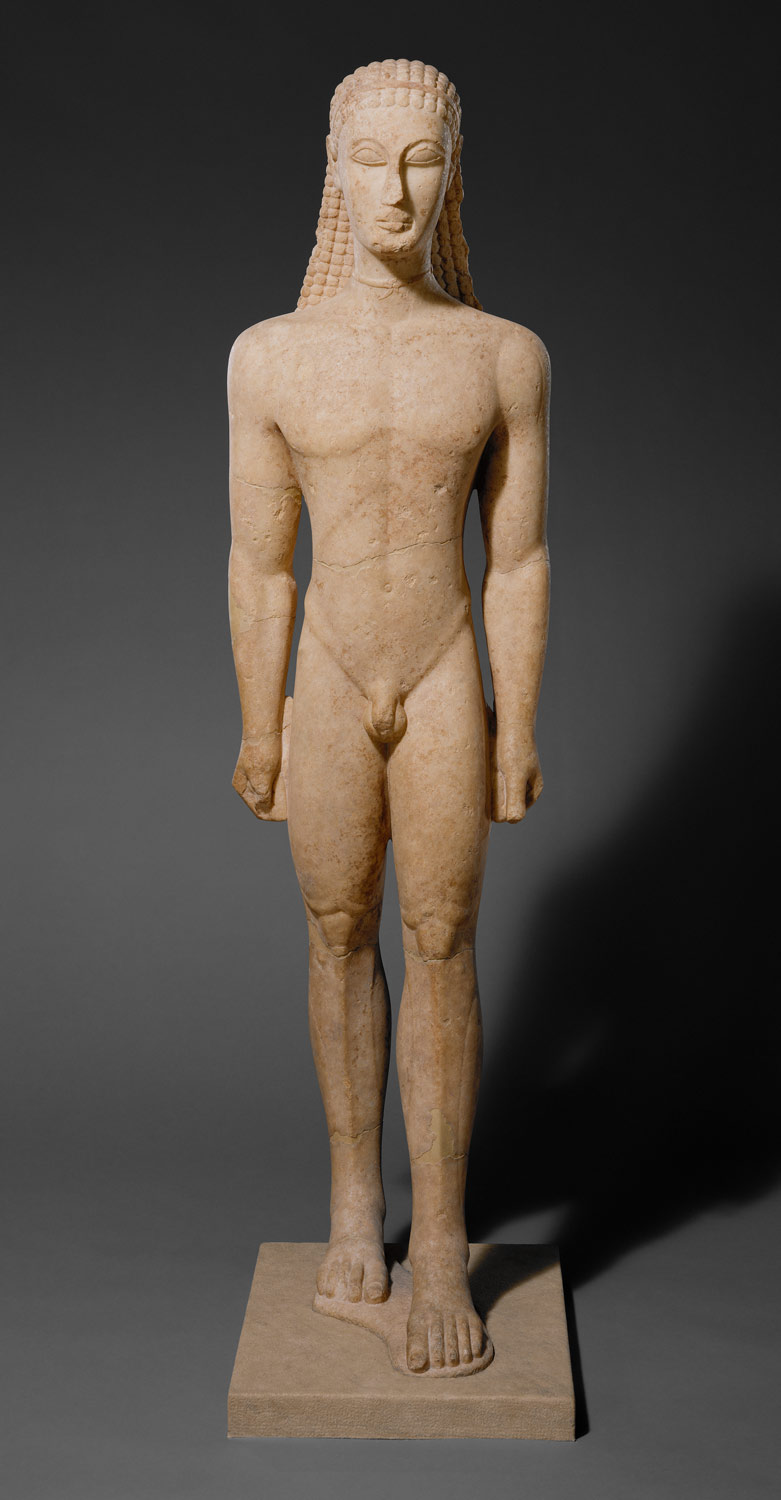
In dissimilarity we meet humanism start to ascend in ancient Greece. Nosotros get-go get-go to run into it in the sculpture of Kouros, 600 BCE. Kouros slightly resembled Egyptian statues, like the statues of Menkaure and Queen. Merely he contradicted them by existence a bit more than realistic in the body and in the details. Kouros was the representation of manhood and perfection at the fourth dimension. He was as well different in his pose and in the mode he was created. He is positioned with ane foot in front of the other and the only thing holding him up is his ii feet which differ from Egyptian sculptures that would have something behind them holding them upward. This statue had transcendence and it was made to trespass lifetimes.
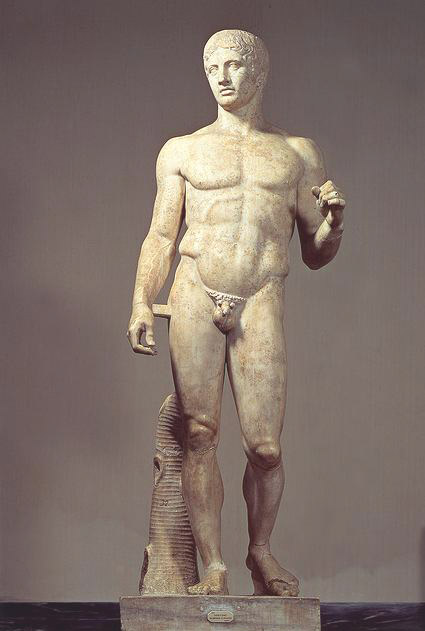
Fast forwarding to 450-440 BCE, nosotros see a completely revolutionized type of statue in Polykleitos Doryphoros. This statue, in particular, had such a focus on the human body. He had details that simply were not seen in the past statues. We see more than details in his abdomen, his pose, and in his arms that even show particular of veins. With his pose we fifty-fifty see movement (contrapasto) , this figure has some kind of fragileness that was merely not seen in the rest of the statues earlier him. It is much more precise in representing humans.
Overall, we see how much fine art has evolved during the centuries. It went through different stages and this classical past was very much emphasized on humanism. It was a such a pregnant affair that nosotros even saw it present in their myths of gods. The Greek gods and their stories sounded a lot like human problems. These deities had man features and human woes. It's very interesting seeing just how much impact humanism had on artwork.

Humanism refers to Greek art and literature, it was important in the Renaissance period. In the most part, fine art had brought color, perspective, and realism. Greeks were not interested in the surrounding reality, in social and political life, they rather represent their earth through the vision and imagination of the artist and the aesthetic standards of the time, responding to represent their surrounding surround and the image of the man in a detail way.
Ane of the ancient Greek art was named kore or korai refers to statues depicting female figures, ever of a young age, which was created during the Archaic period (600 – 480 BCE) Kore statues were most ever standing, in a forward pose with the leg extended slightly forward (rarely with feet together), and with one mitt pulling their dress as if not to stride on it. The free paw was holding an offer to the god or goddess they served
Humanism can be best defined as a shift of focus and placement of importance on Homo in regard to who is the centre of the universe. Previous to this belief, people placed a heavy emphasis on the gods and divine/supernatural matters when concerning anything and everything. Withal, with humanism, Man is at present the center of the cosmological order. He is the prime number amanuensis for change, and it is Man'due south duty to help himself and make things happen. Man is the amanuensis of crusade and effect, not any of the gods or divine nature from the by or present.
When because Greek and Roman art in relations to Mesopotamian or Egyptian Art, humanism is difficult to button to the side because it practicallyisthe difference. Taking a closer look at Mesopotamia and Arab republic of egypt there is a repeated pattern of divine worship within their artwork. Greek and Roman art embody humanism within their piece of work, and the Greek especially emphasized naturalism, anatomy, movement. They really honed in on what man can do. Fifty-fifty when at that place are depictions of divine Greek gods and goddesses, they oftentimes possess human being qualities such every bit a greed and vanity, all of which work to farther affirm that human beings are at present viewed with value.
In taking a look at The King Menkaure (Mycerinus) and Queen sculpture in comparing to the statue of Polykleitos, Doryphoros, these differences are highlighted. Egypt's statue of the King Menkaure and Queen are stiff, direct bodied, with very rigid figures. There is a lot of verticality seen as well and if y'all were to cutting their figures correct downwards the middle they would exist symmetrical. They're likewise clothed, or there's at to the lowest degree the illusion of clothing. This is highly important to the Egyptians, as nudity was seen as an embarrassment. When looking at Polykleitos, Dorpyphoros the details of the work are crisper, and there's an emphasis of physicality and freshness of the homo torso. Different The Rex Menkaure and Queen, we actually run into a facial expression in Polykleitos, Doryphoros. There'due south even a piddling personality seen inside non just his facial expression but his opinion too, both working together to make him seem very passé. He'due south not only anatomically correct but also shows a naturalism in his motility. He can move in most any direction, there is potential energy. This frames him in a gentle South bend, that differs from the rigid and symmetrical ways of the Egyptian statue, a effigy who seems fully live.
Humanism is an ideology that believes values and needs are more important then religious beliefs. Humans are suppose to ignore their needs and desires and work on creating their own set of ideals. Humanism emphasized on what the human was capable of. Humanism in Greek and Roman art were portrayed through creating a central focus on human art. Throughout Greek and Roman art piece of work the ideologies of the Renaissance were portrayed in every aspect. The Renaissance was a period where at that place was emphasize on classical learning, human being potential , and achievements. When looking at Greek and Roman art they seem to be stuck in a moment. This ways that there is and so much detail in the fine art of the Greek and Roman that information technology seems similar they or on interruption and you can figure out exactly what their purpose is and motive is. Greek and Roman art was usually portrayed in nudity which showed the confidence they had with their bodies. In contrast, humanism in Mesopotamian art and Egyptian fine art were used for the worship of kings and gods. Although they would have human like features their would exist emphasis on the bulging eyes to let the kings and gods know that how devoted they were to them. Their art piece of work was unremarkably covered in vesture and loins to glorify their modesty, since nudity was frowned upon. While art in Ancient Greek and Rome was used to glorify the athleticism and sports whereas in Mesopotamian art and Egyptian art were used to devote their attention to organized religion.
Kroisos from Anavysos is an art piece that is very item orientated. Although information technology is a statue of a man you can clearly run into the details that portray the elements of humanism. While looking at this statue y'all can come across the toes, fingers, hair, eyes , nose, expression and posture. This statue seems to be in a completely natural state Where information technology shows that this statue was not for a religious purpose information technology was but an actual person who was more than likely modeling for the artist.
Anubis an art piece from Egyptian fine art that has a head of of a jackal and the torso of a man and is the god of the dead. Anubis weighs your heart to a feather. This is to see if your sins weigh more or less than a feather. The whole aspect of sinning comes from organized religion. That we delight god past NOT sinning. Mesopotamian and Egyptian Fine art also show the hierarchy and the social status with the pharaoh shown to be the biggest and on the acme while accompanied past his followers who are of similar or smaller size and the slaves which are the smallest and the lowest.
Humanism is perspective of which an era of time valued the trunk's capabilities. Well-nigh prevalent in the Ancient Greek Art era, the various sculptures carved had defining features but establish within Ancient Greece. The idea that Man'southward near valuable backdrop was their body's structure and abilities became the principal common feature among the big stone sculptures recovered from the expanse.
Aboriginal Greek and Egyptian Fine art share and differ in various ways. Amongst both groups of statues, both share similar homo qualities like body construction and some forms of poses. They also differ in the style the body construction was modelled. In Egyptian Art, human figures were frequently sculpted and moving-picture show in a sideways view with some third dimension backdrop. This portrayed the figures to take their left human foot in front of their right forming this semi-stable but uncomfortable position. In Ancient Greek Sculptures, male person figures were sculpted in a form that they counter-balanced their weight with their limbs in different positions. This portrayal signifies the idea that humanism was highly valued. The body language of the male sculptures adult the form described as Contrapposto.
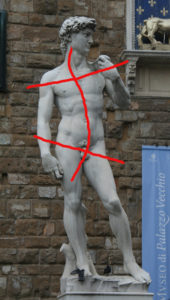
Humanism is a organization of thought attaching importance to humans rather than divine or supernatural matters. It stresses the potential value and goodness of human beings, emphasizing mutual human needs. Art of Greece and Rome. This is depicted in the beliefs and personality of the Greek gods. The Greek gods, felt jealousy, anger, happiness, among other homo emotions. This is different from many modern day religions in which the highest effigy must be one dripped in perfection, non-human like in many means. It allowed for believers to better resonate with the gods.
The art of Greece and Rome were more realistic and a better representation of an actual man. They fabricated their works of art to show man rawness by incorporating facial expressions, torso movement (or body in motion), and fine detail. Kroisos from Anavysos which was merely a homo statue of a man. However, the item included in the sculpture employs the elements of humanism. There was less focus on any divine or religious connection, and more accent on man features. Torso parts such as fingers, toes, and muscles, besides as posture and expression all showed that this was an bodily person who was nearly likely modeling for the artist. Withal, humanism in this sculpture shows the difference in societal ideals the Greeks and Roman's had in comparison to the Egyptians and Mesopotamians.
In comparing, Mesopotamian or Egyptian views art nude depictions of individuals every bit a taboo. Beingness nude was frowned upon and oft used as a class of embarrassment. The ancient Egyptian statues often lacked movement, stood straight, and featured brute figures, usually the head, on the human trunk. Being function animal demonstrated that they were seen every bit divine and as superior to humans. An example of this would exist Anubis, which has the head of a jackal and the body of a man and is the god of the expressionless. Anubis was the god of embalming and the dead. Since jackals were often seen in cemeteries, the ancient Egyptians believed that Anubis watched over the dead
Humanism is an overall shift to the idea of what humans are capable of and can produce, rather than relying and basing statement on divine or supernatural factors. This was a shift in mindset, practices, and certainly artwork. A major factor in developing the humanistic ideology was the Greek gods and goddesses. Greeks identified that their gods had flaws and faced issues that mortal beings faced. As a result, it allowed the individuals to resonate more with the gods, only as well rely less on gods and more on their own capabilities. Greek and Roman artwork greatly illustrates humanism when compared with aboriginal Egyptian and Mesopotamian artwork. To begin with, Greek and Roman artwork are much more detailed than Egyptian and Mesopotamian. Greek and Roman sculptures had a more realistic advent and looked like an actual person 1 could recognize. There was more emphasis on the face with distinct facial features and expressions, but also details in places one wouldn't pay attention to correct abroad such as fingers, feet, muscles, and posture.
To illustrate the difference, an case of Egyptian fine art is Anubis and mummification. Anubis was the jackal-headed god of embalming that watched over the dead. This is a adept instance in comparison to Greek and Roman artwork considering it's 2 dimensional, so there is less room for detail equally opposed to a sculpture. Still, what the art represents is as well a representation of Egyptian civilization. The Egyptians were very focused on gods and religion and they would base their thinking on divine or supernatural power. By presenting art with a half-man half-jackal being who helps individual be closer their god, the fine art is employing divine features rather than humanistic.
An example of Greek art is Kroisos from Anavysos which was only a homo statue of a human. However, the item included in the sculpture employs the elements of humanism. There was less focus on whatsoever divine or religious connection, and more accent on human features. Body parts such as fingers, toes, and muscles, as well as posture and expression all showed that this was an actual person who was nearly likely modeling for the artist. Nonetheless, humanism in this sculpture shows the differing ideals that the Greeks and Roman's had compared to the Egyptians and Mesopotamians.
Thus far the Ancient Worlds that we have learned about in class tended to create works of art that were more naturalistic instead of humanistic. Examples of Ancient Worlds that focused on naturalistic art were Mesopotamia and Egypt, where there was more than of a focus on the Gods and that everything else was surrounded by the Gods. In contrast, Greek and Roman art focused on humanism. Humanism focused and emphasized humans as the "principal object" of the world and that instead of Gods, humans were, in a mode, at the middle of the universe. Humanism focuses on human values, beliefs, and individuality; and that humans have the capability to be good. In terms of Greco-Roman art, humanism meant putting an emphasis on the human potential, likewise every bit the human torso.

For example, in the Ancient Egyptian sculpture, Seated statue of Pharaoh Seti (*picture would non upload), humanism is not portrayed. In this sculpture, the human body is non emphasized and instead his rank his emphasized. For this slice of artwork, the eyes are instantly drawn to the Pharaoh's headpiece, the object in hand, and his feet that are on top of an object in order for them to not impact the ground. All of these observances tin instantly make the viewer come to the conclusion that this person was in fact a Pharaoh and therefore of very high rank. In improver to that, the Pharaoh's body is not emphasized, and instead the viewer can see the outlining of the garments that the Pharaoh wears, again demonstrating social class and power.
In contrast, in this Greek sculpture, Discobolus, humanism is very axiomatic. Near noticeable is that the naked human torso is on display, clearly showing human accent. The Greeks saw the display of the man body as something natural and something "show off" and have pride in. Their bodies showed their strength and exuded their power. The Greeks did many things in the nude, as it was considered the norm, even the Olympics were done in the nude. This sculpture does not put an emphasis on rank or social class, it is ambiguous and is left for the viewer to presume.
Humanism is a concept that emphasizes " attaching prime importance to human(due south) rather than divine or supernatural matters", it is the report of human beings. In fine art, Humanism manifested through paying more attention to Human being item to make them look more man, through highlighting and detailing humanistic traits such every bit giving pilus more particular- making it more than realistic, making bodies more large and detailed (highlighting things such as stance, genitals, muscles etc). This was very important in the ancient times because it was a large switch from encompassing life and its significant to supernatural and divine figures. Humanism presented more realism in the people'due south lives. Humanism helped not only amend the quality of art and sculptures; however, it likewise helped show the evolution of art and how it was done before and how information technology developed.
Greek and Roman fine art, portray Gods equally more human;
(Statue of Kouros)
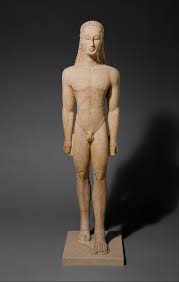
whereas, Egyptian and Mesopotamian Gods are portrayed in a more dehumanized way having brute heads etc, nevertheless only because they were seen as divine and non as equivalent to humans, simply superior. Egyptian art had more of a mystical experience to it rather than a realistic one.
(Painting of Anubis, a God with a jackal head)
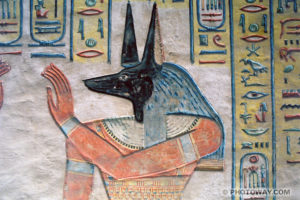
Hither is a juxtaposition of Greek and Egyptian art:
(Marble statue of Kouros vs. King Menkaure and Queen statue)

Conspicuously the inclusion of Humanism was revolutionary considering "it valued humanity in that it began to place human being beings @ center of moral and social concerns and gave more valoration to things such as the human being body".
Humanism is the system or movement of human beings. In terms of art, humanism shifts the focus in where man becomes the agent for change. Information technology emphasizes the value and individuality of humans. In Greek and Roman art, humanism is very common equally information technology is the main focus in majority of the pieces of art. In Egyptian and Mesopotamian fine art, they focus more on a higher power that is greater than flesh where as in Greek and Roman fine art, they focus more than on the human being itself.
On the left we have the Sumerian art of theContinuing male worshipperand on the right we accept the Greek art of theKouros of Kroisos from Anavysos. In the Sumerian art piece, it represents a religious standpoint. The figure is a sign or a symbol of a higher power. The figure is covered and has detailed lines beneath (nigh like a dress or a robe). In Mesopotamia, nudity was a sign of humility which is why the effigy below isn't nude. The eyes in the male person worshipper piece are wide and distinct and is 1 of the first things that draws your eyes. In the Greek art piece of theKouros of Kroisos from Anavysos, the figure has more than features of a homo than of a higher ability. It has one foot in front of the other and is completely nude. For Greek, nudity was a sign of culture and pride. The men and boys that were sculpted all appeared nude equally information technology was a manner to show forcefulness and power. The eyes in the pieces aren't as distinctive as the male person worshipper. In both fine art pieces, they accept very intricate waves and chaplet/braids to stand for the bread on theContinuing maleworshipperand the pilus on both theKouros of Kroisos from Anavysosand the male worshipper. Both pieces are also proportionate in symmetry and are stiff.
Source: https://art1010shawfall18.commons.gc.cuny.edu/tag/blog-8-humanism-in-greek-art/
0 Response to "Greek Art Is Said to Be Humanistic Because It Refers to"
Post a Comment